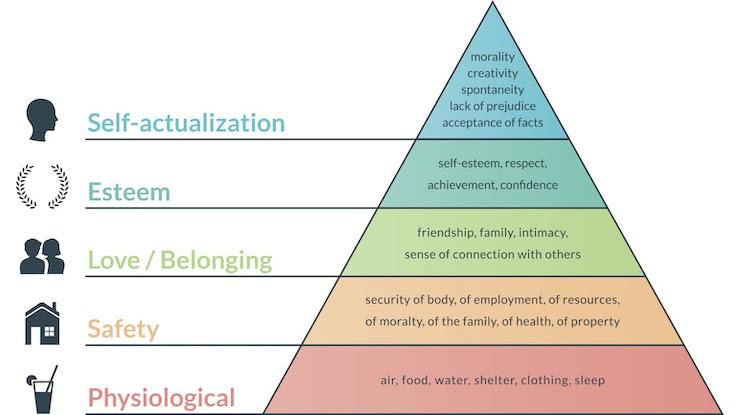What Is Maslow’s Hierarchy of Needs — & What are Its Advantages & Disadvantages?

Maslow’s hierarchy of needs is a psychological theory of human behavior and motivation, often illustrated as a pyramid that consists of five levels. The theory states that the needs on the bottom level of the pyramid must be satisfied before any of the needs on the higher-up portion of the pyramid can be addressed.
One clear advantage of Maslow’s hierarchy of needs is its perceptive insight into human nature, but a glaring disadvantage is that the hierarchy fails to account for cultural or social differences between individuals — or considerations of equity and systemic oppression. In 1943, Abraham Maslow first introduced the theory in a paper titled “A Theory of Human Motivation.”
As you can see in the above illustration, the bottom of the hierarchical pyramid is filled with physiological needs, such as water, food, and shelter. The next level is dedicated to safety, while the third level is composed of emotional needs, such as love, belonging, connection, and friendship. The fourth level concerns esteem-related concerns, including self-esteem and respect, and, finally, the highest level of the pyramid is dedicated to self-actualization, something that only occurs when a person achieves their full potential. So, why are we driven to attain those highest levels of the pyramid? Maslow believed human beings crave personal growth.
Advantages of Maslow’s Hierarchy of Needs
Maslow became known as a founder of the school of thought called humanistic psychology in the 1950s, which helped serve as an enormously influential template for understanding how humans organize and manage their behavior. Maslow’s ideas challenged many of the other popular theories of the time, and, in doing so, changed the course of psychology.

For instance, Freud’s theory of psychoanalysis put a lot of emphasis on the unconscious mind and sought out the more negative aspects of the human experience. Additionally, Skinner’s theories regarding human behavior often put too much stake into what is wrong with how humans behave. By contrast, Maslow focused on optimizing the human experience by helping people reach their full potential.
One of the greatest strengths of Maslow’s hierarchy of needs is that it provides thoughtful insight into human nature since it helps to explain human behavior and motivations. This is especially true when thinking about more universal motivations, which can be adapted to humans over time. That is, it could be applied to humans hundreds or thousands of years ago just as much as it can be applied to folks in our modern world.
Furthermore, Maslow’s theory productively summarizes human needs, so it can be applied to most fields. For example, understanding human motivation and behavior in terms of the hierarchy of needs can help managers provide the proper environment for their employees to thrive, benefiting both the company and themselves. With this in mind, the theory can help people in their personal lives as well, providing a blueprint for achieving their full potential through each level of the pyramid.
Disadvantages of Maslow’s Hierarchy of Needs
The more glaring disadvantage of Maslow’s hierarchy of needs is that he ignored the fact that not all humans think exactly the same way. In our uniqueness, humans have differing motivations and values. For instance, some people place more value on social acceptance than safety. For others, social affection and attention are not a big part of where they get satisfaction in life and prefer to be introverted or avoid anxiety-inducing social situations.

Additionally, Maslow did not account for the huge array of cultural differences among humans around the world. That is, all cultures and groups of people hold different values, but Maslow applied a very Western point of view to his theory. To apply the same hierarchy of needs to everyone despite those differences means ignoring those differences and how they impact human motivation and behavior.
One clear example revolves around family life. In some cultures, once children grow up, they build their own lives and take care of just themselves. In other cultures, children bear the responsibility of taking care of their parents as they age, which often includes living together once the parents reach a certain age. As such, the hierarchy of needs model becomes less clear since motivation can’t be generalized so broadly.
Why Is Maslow’s Theory Criticized?
Maslow’s hierarchy of needs is most criticized in terms of its lack of empirical evidence. Because there is no way to accurately measure the level at which a person has satisfied one of the needs on the pyramid, it is impossible to tell what it takes to “move up” to the next level. In other words, how safe does a person have to feel before they can move up to the next level? How socially content does one have to be before they move closer to self-actualization?

Additionally, defining what things like “self-esteem,” “security,” and “self-actualization” mean is a challenge. Across cultures, these terms can be defined in a variety of ways. To one person or cultural group, self-actualization might mean something entirely different to another person with a different set of values. In these ways, Maslow’s theory falls short.
Why Is Maslow’s Theory Important?
Regardless of its shortcomings, Maslow’s theory remains important for its contributions to understanding human motivation and behavior at large. Over time, many scientists have come up with ideas about how the human mind works that have contributed to the field of psychology. Even if the whole of their theory doesn’t end up explaining everything about how humans operate, pieces of the ideas from each theory help us better understand human motivation and behavior. Therefore, each theory has an intrinsic value.

Moreover, Maslow’s hierarchy of needs has helped us progress our understanding of human behavior by changing the focus to the positive aspects of our natural way of being. For example, his model placed focus on positive and proactive means of attending to mental health. What’s more, Maslow’s ideas have had a huge impact on the way we perceive mental health in general. Without a doubt, his attentiveness to human potential and dedication to improving lives continues on in the field of psychology today.





